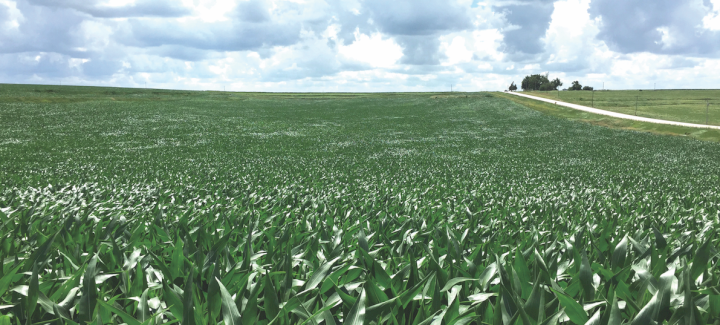
The June 27, 2023, U.S. Drought Monitor Map reports that large areas of Nebraska, Kansas and Missouri, and some areas of Iowa, South Dakota, Oklahoma and Texas, are experiencing extreme to exceptional drought conditions. Many areas of the Midwest, South and East Coast are experiencing abnormally dry, moderate or severe drought conditions. The National Drought Summary states, “The Midwest and east-central Great Plains saw mostly worsening conditions and widespread crop stress and low streamflows after another week of mostly dry weather.”
Stine® agronomists and sales reps have been fielding questions recently about managing Stine corn and soybeans during a drought.
“There are a number of concerns growers need to be aware of when it comes to drought and crop production,” says Tom Larson, Stine’s director of agronomy. “Drought stress in plants obviously impacts plant performance, but growers also need to be aware of issues related to herbicide carryover.”
What are the effects of drought on plants?
The U.S. Drought Monitor notes that 70% of corn and 63% are soybean production areas are currently impacted by drought conditions.
The negative effects of drought on crops can result in significant yield loss if dry conditions persist throughout the growing season, especially right before or during the critical pollination stages.
Drought symptoms on corn
The initial symptom of drought stress in corn is leaf rolling. This typically occurs during the day. Long periods of drought during the vegetative stages can result in shorter, stunted plants and less leaf area. Growers may also note leaf discoloration. If drought persists through the pollen shed stage, yield loss can truly gain ground.
Dr. R.L. (Bob) Nielsen of Purdue University notes, “Stress during pollen shed and silking can cause more yield loss than almost any other period in the crop's development … During the silking and pollen shed period, severe stress may reduce yield up to 8 percent per day. During the 2 weeks following silking, severe stress may reduce yield up to 6 percent per day.”
Later in the season, if pollination was impacted by heat stress, it can lead to poor grain fill, aborted kernels and leaf tissue death.
“Now that we’re getting closer to the pollination stage in corn, that’s when heat stress can really take hold and damage yield,” said Larson. “Drought conditions can lead to delayed silking or stunted silks, which greatly impact the pollination process and grain fill. Fortunately, Stine has many corn hybrids that feature some drought resistance and are bred to perform under drought stress. While we’re hoping for rain, it will be interesting to see how these hybrids yield come harvest if the current conditions persist.”
Stine has several corn hybrids that have a longer flowering period, which can help insulate the crop from drought stress to a degree by having pollen shed over a longer period. Connect with your local Stine sales rep to explore these options for the 2024 season.
Drought symptoms on soybeans
“While soybeans are also subject to yield loss related to drought stress, they’re not affected as severely as corn,” said Larson.
Soybean drought stress can initially appear as leaf curling (or flipping) in the vegetative stages. Continued drought stress can further impact the plant by stunting leaves and early flowering, which affects pollination.
Experts from Iowa State University Extension and Outreach note that the “Soybean is most susceptible to water deficits
during germination and the reproductive growth stages. Soybean yield loss from water deficits is caused by a reduction in flower number, pod number, and seed fill during the reproductive stages of growth.”
Drought stress can also lead to fewer seeds per pod, smaller seed size and seed abortion in soybeans.
Drought and herbicide carryover
“Herbicide carryover should be a consideration for growers during a drought year,” says Larson. “Plants under stress don’t metabolize chemistries properly, so it takes longer for it to flush through their systems. Herbicides carried over from the previous year may be present in the soil as this year’s crop grows. If this year’s crop doesn’t have tolerance to that chemistry, you could have a big issue on your hands.”
Herbicides applied in the spring or early summer have more time to break down in the soil. However, herbicides that are sprayed in season post-emergence have a shorter half-life and may cause issues for the next growing season.
“For any corn herbicides that were sprayed late last season, we’re seeing some of that chemistry impact this year’s crop as the chemical has not broken down by now,” said Larson. “To ensure this year’s herbicides don’t carry over into next year, you need to time your herbicide applications and select your chemistries wisely. Look for something that you know won’t impact next year’s crop or choose a corn or soybean product that has tolerance to that chemistry. Your Stine agronomist or sales rep can help you with these decisions.”
To learn more about drought’s impact on corn and soybean crops and the potential for herbicide carryover, contact your local Stine sales rep or regional sales agronomist today.
Related Articles
-

Stine® to offer Syngenta’s Victrato® soybean seed treatment in 2026
December 2025 in Agronomy
-

Use Stine’s XP® seed treatments to prevent early injury to your crops
December 2025 in Agronomy
-

Understanding Stine’s enhanced oil profile soybeans
December 2025 in Agronomy
-

Soil sampling sets the stage for spring
November 2025 in Agronomy



